Introduction to the Journey
Bonnie W. Styles and Terrance J. Martin
Illinois State Museum
Khants at a summer camp, 1888. No. 3954-3.
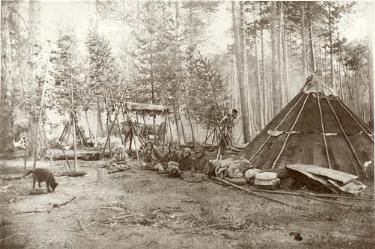
Journey to Other Worlds explores, through over 200 objects of material culture and a magnificent collection of archival photographs, the late-nineteenth- and early-twentieth-century lifeways of fourteen ethnographic groups distributed across Siberia. The regions of Siberia and the ethnic groups represented include western Siberia (Nenet, Khant, and Mansi), central Siberia (Sel'kup, Nganasan, Dolgan, Ket, and Evenk), and eastern Siberia (Yakut, Even, Koryak, Negidal, Chukchi,
and Chuvantsy). The material culture and photographs illustrate the fabric of daily life of Siberian reindeer hunters and breeders and the interrelationships between environment, economy, domestic life, and spiritual life. The exhibit captures the spirit of the Siberian peoples in their various adaptations to the climatically harsh, arctic environments, which ranged from treeless tundra to mixed forest and tundra to the forested taiga. The essay by Valentina Gorbacheva provides an overview of the
distribution and cultures of these groups.
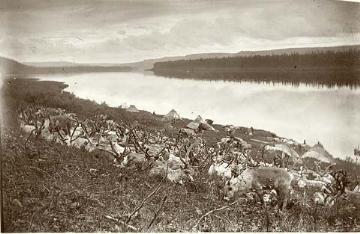
Evenk reindeer herd and camp, early 1900s. No. 5659-37.
Evenk hunters on skis, early 1900s. No. 5659-35.
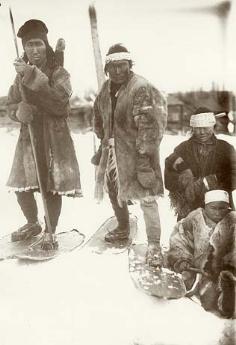
The reindeer (Rangifer tarandus) played an integral role in the lives of these groups, providing sustenance; hides for clothing and house coverings; hair, bones, and antler for tool and ornament manufacture and works of art; sinew and tendons for ropes, cordage, and thread; a means of non-pedestrian transportation; and a central figure in ritual and ceremony.
The reindeer, which is the same species as the North American caribou, migrates great distances to find adequate food and shelter from insect pests. In the summer, they migrate to higher altitudes and cooler climates, in part to avoid insect pests; in the winter they migrate toward greater tree cover. All of the fourteen ethnic groups represented in the exhibit used reindeer within a broader-spectrum economic system that variously incorporated hunting and trapping of other fauna, such as moose, bear, foxes, mustelids, quirrels, and a variety of birds; fishing for species such as salmon and sturgeon; and use of marine mammals, including seals and walrus, for groups situated along the coast. Features of this system varied depending on cultural traditions, geographic and local environmental settings, and influences of and interactions with neighboring groups. However, the herding and migratory behavior of the reindeer played an important role in shaping the subsistence and settlement patterns for these groups. Items associated with hunting and herding of reindeer; the portable dwellings; numerous objects made from reindeer furs, hides, sinew, bones, and antler; and the representations of reindeer in art and ritual objects attest to the central role of this animal in economy and beliefs.
Khant hunter with crossbow, 19091910. No. 1706-50.
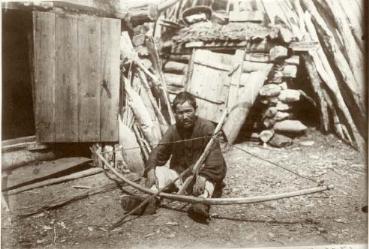
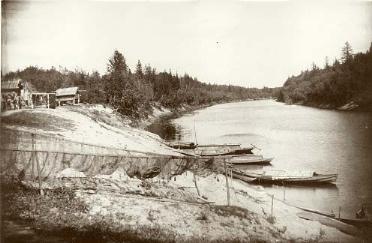
Khant boats and fishing nets at a camp in western Siberia, 1888. No. 3954-12.
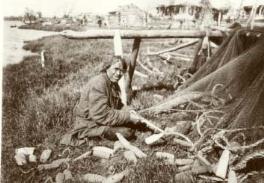
Khant fisherman tying floats to a net, 1909-1910.
No. 1706-71.
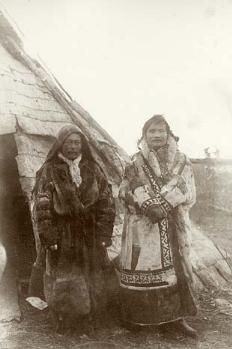
Khants in traditinal clothing standing next to a chum.
No. 1706-83
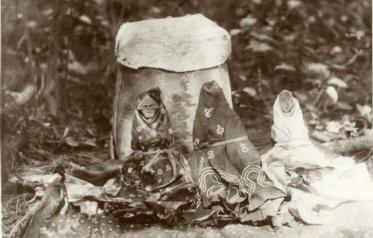
Idols and birch-bark basket container, Khant, 1888.
No. 3954-28a.
Amongst some Siberian groups, the ancient practice of shamanism and ritual
associated with reindeer hunting and propitiation continues to this day. The shaman performed important rituals associated with hunting and curing and provided a link to the upper and lower worlds of the Siberian cosmos. When added to oral histories and the rich historic descriptions of Siberian shamanism, the elaborate costumes and accoutrements of the shaman convey the world view and the important role of the shaman in these societies. The articles by Karina Solovyova and Tatyana Sem provide overviews of Siberian shamanism.
Evenk hunter loading his gun, early 1900s. No. 5659-28.
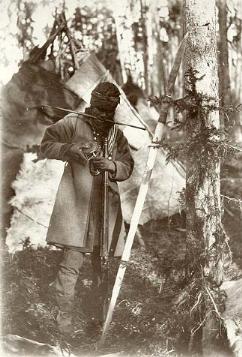
The transition from hunting of wild reindeer to herding of wild animals and then to domestication and breeding of animals was probably gradual among these Siberian groups. Some scholars suggest that the practice of reindeer breeding may have already emerged
in the area during the first century A.D. as a result of contact with Turks and Mongols of Central Asia who were breeding horses. The practice undoubtedly produced some changes in lifeways; however, it was incorporated
into a long established pattern of herding. More dramatic changes can be attributed to the intrusion of Russians during the fifteenth through the eighteenth centuries. The Russians established a lucrative trade in furs
with the indigenous Siberian populations. The Russians exchanged rifles, iron tools and utensils, glass beads, tobacco, tea, and flour for furs from sable and fox. The fur trade ultimately became an important source of income
for some Siberian groups. This interaction is represented in the flintlock gun, iron objects, and
glass beads, which adorn numerous articles of clothing in the exhibit. The lifeways documented in this exhibit were further modified through political changes and industrialization. The final essay by Valentina Gorbacheva elucidates some of these changes.
Khant hunter,
1915. No. 3939-52.
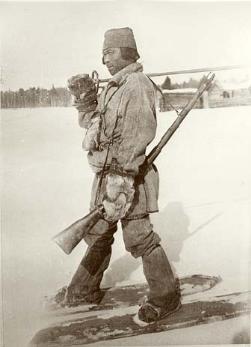
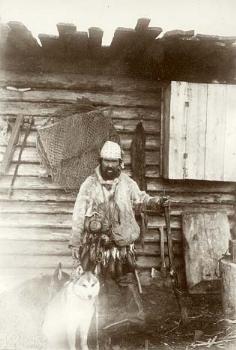
Khant hunter with huskies, 1909-1910. No. 1706-75.
Not surprisingly, inspection of elements of traditional Siberian cultures reveals parallels to those recorded for many Native American groups in North America. These include shamanism, the cosmology of the three worlds, animal symbolism, the widespread practice of bear ceremonialism, and many features related to residential mobility. An appreciation of the similarities and differences in the respective geographical contexts contributes to a better understanding of traditional cultures in both Siberia and North America.
Evenk smiths at work, early 1900s, No. 5659-87.
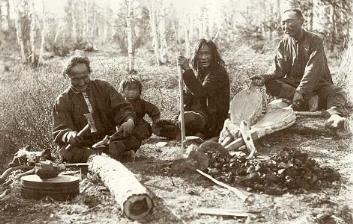
The exhibit title, Journey to Other Worlds, is a triple play on words. We invite you to journey in space to see the collections from the Russian Museum of Ethnography, to journey in time to various regions of Siberia
during the late nineteenth and early twentieth centuries, and to journey in the mind to explore the mysticism of Siberian shamanism. We hope you enjoy the Journey.
Evenk woman with her daughter, early
1900s. No. 5659-22.
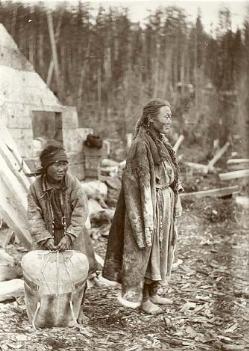

Map of Siberia showing distributions of ethnic groups represented in the exhibit.
Foreword|
Intro|
Hunters|
Shamans|
People|
Healing|
Readings|
Objects














